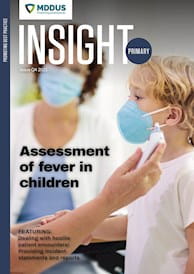 A GP outside Manchester suffers a fractured skull in an alleged attack by a “frustrated patient”. A branch surgery in Staffordshire closes its doors for two days as staff walk out in protest at patient abuse. A practice receptionist tells the BBC she has “never seen this level of abuse” in her 34-year career.
A GP outside Manchester suffers a fractured skull in an alleged attack by a “frustrated patient”. A branch surgery in Staffordshire closes its doors for two days as staff walk out in protest at patient abuse. A practice receptionist tells the BBC she has “never seen this level of abuse” in her 34-year career.
Such stories are appearing regularly in the media across the UK, with healthcare professionals reporting a steady increase in abuse and aggression directed towards practice staff as the pandemic lingers on.
Frustration is boiling over for a variety of reasons, including patients being unable to book face-to-face appointments, requirements to wear face masks while in the practice, and delays in telephones being answered.
Conflict situations by their very nature can quickly escalate, not only face to face and on the telephone but also with patients venting their anger against practices on social media or by making formal complaints. All of this can have a serious effect on staff, who may feel unsupported and unable to cope with the stress of being exposed to hostile patient encounters.
GP practice employers must treat the potential of such encounters as a health and safety at work matter, with a legal obligation to take reasonable steps to mitigate and minimise the associated risks.
The focus should first be on actions that can prevent conflict situations arising in the first instance, or to reduce their frequency. These include:
- establishing related policies
- implementing safe systems of working
- carrying out risk assessments
- providing staff with necessary training.
Here are some approaches to consider.
Training and policies
Staff training. Consider providing guidance and training on how to prevent conflict escalating. Typically this focuses on the effective use of interpersonal skills such as defusing and calming strategies, or team tactics to de-escalate and control a conflict situation.
Update practice policies. Review and update your practice’s unacceptable patient behaviour policy as a reference for reception staff, practice managers and clinicians. Signs or posters can be put up on the front door of the surgery and in the waiting room, and notices posted on your website/social media platforms reminding patients you have a policy that prohibits aggression, threats and violence towards staff and other patients. This should provide examples of behaviours that cannot be accepted, along with the potential consequences.
Make patient information easy to find. Provide detailed information for patients about your current appointment booking systems, contact methods and other related pandemic arrangements. Clearly display this on your practice’s website or other social media platforms, and state in your recorded telephone message.
Exit strategy. Discuss with all team members the importance of having a viable exit safety strategy if unexpectedly faced with an aggressive or violent patient. This has to be something that is plausible and comes quickly to mind for the individual, acting as a trigger for them to get up and leave the situation. In this context, it is also important to ensure that consulting rooms and other patient interaction areas offer staff an uninterrupted pathway to the exit. Make sure there is no furniture or other obstacles blocking the way to the door and safe exit. Risk assess the layout of your consulting rooms in advance with this in mind.
Panic alarm protocol. If your practice is equipped with panic alarm buttons, check that everyone is familiar with where these are located and what happens if you press one. The practice should have a protocol for what to do if a panic alarm is activated, and everyone should be familiar with this. Consider running a practice drill to assess how everyone responds, similar to a fire alarm test.
Ending the patient relationship. In extreme cases, practices may consider terminating the practice-patient relationship if unacceptable behaviour cannot be managed in any other way. Be sure to follow GMC guidance on this, or contact MDDUS for advice on how to go about this correctly. Patient communication
Clear communication. Developing and encouraging the use of clear communication channels with your patients can assist in preventing challenging situations arising and help quickly calm a difficult face-to-face situation. This should certainly include providing an explanation of the causes behind a frustrating situation and an apology for any inconvenience.
Understanding why conflict arises. Having a team discussion about potential sources of patient frustration and how to minimise the flash points that may act as triggers for patients will help everyone’s understanding of the problem. Consider how to keep patients involved and engaged in their journey through your practice. This can be as simple as explaining to them how long they will have to wait to be seen.
More than anger. Practice staff should be reminded that aggressive behaviour should be distinguished from patients simply experiencing anger or annoyance, which are legitimate emotions that often arise from frustration and anxiety. Unfortunately, some individuals are unable to express these feelings constructively and resort to becoming aggressive, which should not be tolerated.
Listening to patients’ concerns. Even if a patient’s behaviour is inappropriate, it can help if practice staff take the time to listen carefully to their concerns and offer appropriate solutions where possible. Simply cutting a patient off without an explanation or appropriate apology may only lead to a situation escalating out of control.
The pandemic factor. More specifically, in the context of Covid-19, your staff can try to place the patient’s frustration in the broader context of the immense challenges of the pandemic. This approach can help develop empathy, which in turn can reduce tension when providing factual explanations behind perceived “bad news”.
Empowering staff. In the most extreme situations, your staff should be empowered to make it clear that aggressive behaviour or violence will not be tolerated, in line with your unacceptable behaviour policy. This should be calmly communicated while attempting to manage the situation, for example by acknowledging that a complaint has been made and will be acted upon in accordance with your complaints policy.
Supporting staff
Post-incident support. This should encompass guidance on actions to take after an incident has occurred to support staff and prevent or reduce the potential for recurrence. Attention should be focused on the effect of single or cumulative instances of conflict on individual staff, including psychological harm. It is important to allocate protected time for all staff to debrief and de-stress following serious incidents.
Independent advice. Do you provide access to an independent employment assistance program to support your team? Individuals often find approaching managers or colleagues difficult as they worry about appearing weak or unable to cope. Remember that developing a strategy to prevent and reduce patient conflict will help reduce frustrations for both your patients and staff, ultimately lowering the risk of complaints, claims or regulatory action.
Training resources
MDDUS has developed a range of learning resources and events for members on managing patient conflict.
Alan Frame is a risk adviser at MDDUS
This page was correct at the time of publication. Any guidance is intended as general guidance for members only. If you are a member and need specific advice relating to your own circumstances, please contact one of our advisers.
Read more from this issue of Insight Primary

Save this article
Save this article to a list of favourite articles which members can access in their account.
Save to library


